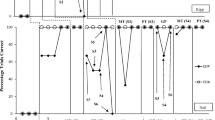Abstract
Recent research on teaching mands for information to children with language deficits has focused on manipulating establishing operations (EOs). However, only a few of those studies have programmed both EO conditions (in which information is needed) and abolishing operation (AO) conditions (in which information has already been provided) to ensure functional use of the mand for information. Shillingsburg, Bowen, Valentino, and Pierce (Journal of Applied Behavior Analysis, 47, 136–150, 2014) provided a successful demonstration of differential responding between EO and AO conditions demonstrating control of the response by the relevant EO. Echoic prompts resulted in successful mands for information “Who?” One limitation of this study was that the participants did not re-issue the initial mand upon approaching the named adult to retrieve the item. This may be problematic in the natural environment as it is unlikely that the named adult would know what the child was looking for. The current study sought to replicate and expand previous research by using textual prompts to teach the mand “Who?” in four children diagnosed with autism (Phase 1) and by requiring the mand for the item be re-issued upon approaching the named adult (Phase 2). Textual prompts resulted in differential use of the mand for information during EO and AO conditions for all of the participants. Additionally, three of the four participants who did not re-issue the mand to the named adult during the Phase 2 baseline did so following the intervention. Overall, results support the use of textual prompts to teach mands for information to children with autism.



Similar content being viewed by others
References
Brown, R. (1968). The development of wh questions in child speech. Journal of Verbal Learning and Verbal Behavior, 7, 279–290. doi:10.1016/S0022-5371(68)80002–7.
Endicott, K., & Higbee, T. (2007). Contriving motivating operations to evoke mands for information in preschoolers with autism. Research in Autism Spectrum Disorders, 1, 210–217.
Ingvarsson, E. T., & Hollobaugh, T. (2010). Acquisition of intraverbal behavior: teaching children with autism to mand for answers to questions. Journal of Applied Behavior Analysis, 43, 1–17. doi:10.1901/jaba.2010.43-1.
Lechago, S. A., Carr, J. E., Grow, L. L., Love, J. R., & Almason, S. M. (2010). Mands for information generalize across establishing operations. Journal of Applied Behavior Analysis, 43, 381–395. doi:10.1901/jaba.2010.43-381.
Lechago, S. A., Howell, A., Caccavale, M. N., & Peterson, C. W. (2013). Teaching “how?” mand‐for‐information frames to children with autism. Journal of Applied Behavior Analysis, 46, 781–791. doi:10.1002/jaba.71.
Schuster, J. W., Gast, D. L., Wolery, M., & Guiltinan, S. (1988). The effectiveness of a constant time-delay procedure to teach chained responses to adolescents with mental retardation. Journal of Applied Behavior Analysis, 21, 169–178. doi:10.1901/jaba.1988.21-169.
Shillingsburg, M. A., Bowen, C. N., Valentino, A. L., & Pierce, L. E. (2014). Mands for information using “who?” and “which?” in the presence of establishing and abolishing operations. Journal of Applied Behavior Analysis, 47, 136–150. doi:10.1002/jaba.101.
Shillingsburg, M. A., Bowen, C. N., & Valentino, A. L. (2014). Mands for information using “how” under EO-absent and EO-present conditions. The Analysis of Verbal Behavior, 30, 54–61. doi:10.1007/s40616-013-0002-7.
Shillingsburg, M. A., Valentino, A. L., Bowen, C. N., Bradley, D., & Zavatkay, D. (2011). Teaching children with autism to request information. Research in Autism Spectrum Disorders, 5, 670–679. doi:10.1016/j.rasd.2010.08.004.
Sindelar, P. T., Rosenberg, M. S., Wilson, R. J. (1985). An adapted alternating treatments design for instructional research. Education & Treatment of Children, 8(1), 67–76.
Sundberg, M. L., Loeb, M., Hale, L., & Eigenheer, P. (2002). Contriving establishing operations to teach mands for information. The Analysis of Verbal Behavior, 18, 15–29.
Vedora, J., Meunier, L., & Mackay, H. (2009). Teaching intraverbal behavior to children with autism: a comparison of textual and echoic prompts. The Analysis of Verbal Behavior, 25, 79.
Acknowledgments
The authors would like to thank Brittany Bartlett, Sunita Joshi, Danielle Richardson, Bethany Hansen, Kelly Schleismann, and Sarah Wymer for their assistance with data collection.
Author information
Authors and Affiliations
Corresponding author
Ethics declarations
Ethical Approval
All procedures performed in this study were in accordance with the ethical standards of the institutional review board and with the 1964 Helsinki Declaration and its later amendments.
Conflict of Interest
The authors declare that they have no conflicts of interest.
Informed Consent
Informed consent was obtained from all the individual participants included in the study.
Rights and permissions
About this article
Cite this article
Shillingsburg, M.A., Gayman, C.M. & Walton, W. Using Textual Prompts to Teach Mands for Information Using “Who?”. Analysis Verbal Behav 32, 1–14 (2016). https://doi.org/10.1007/s40616-016-0053-7
Published:
Issue Date:
DOI: https://doi.org/10.1007/s40616-016-0053-7




